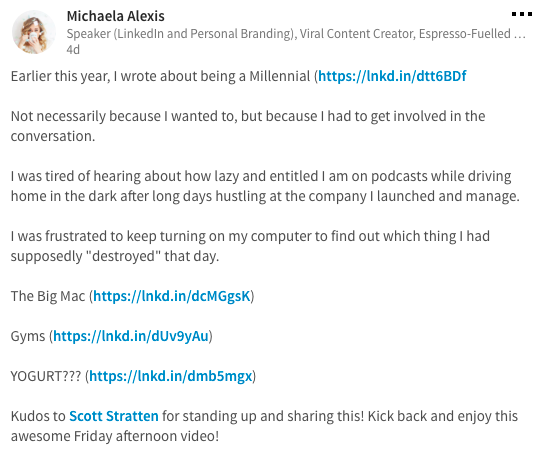
It is not enough to optimize the title of your blog in order to rank highly on Google. The web crawler wants to find keywords within your content, and a basic SEO strategy will make it easier for Google to index and display your content. Headings should also be considered when optimizing blogs for SEO. They allow readers to flow through the content, and search engines to understand the hierarchy of your reading. Use headings to highlight keywords and phrases at the beginning, middle and end of each section.
Meta description
Your meta description should be written in an organic tone for SEO blogs. Your meta description will answer the query of a user and highlight high-quality content. It's a bad idea to make a website look spammy. Keep in mind the golden rule: Write for people, not robots. You will get more clicks. Here are some tips that will help you write compelling meta descriptions:
Make it engaging: Include your main keyword in the meta description. Google does NOT count your meta-description when indexing your webpage, but it does help to grab a user's interest. The most important thing is to keep your meta descriptions between 140 and 160 characters. A call to action should be included in the description, such as a link that takes you to your website. A compelling call to action is also a key part of a good meta description.
The meta description gives you the opportunity to market your company. It is a great way to catch a user's attention and persuade them to click on the link. A high-quality meta description can increase your site's website traffic and increase sales. To encourage users, a call for action should be placed at the end. If your description is too long or contains outdated information, your meta description may be useless.
A meta description is not only readable but can also increase click-through rates. Properly using the meta description can increase both your organic traffic, and your ranking. The meta description plays a moderate role in Google's search engine results. Your meta description may not be optimized well enough to rank your page on page four, instead of page 1. A meta description is worth the effort even if you have a low click-through.
Keywords in the title
Focused keywords must be used in the title of SEO blog posts to get the best results. Keywords in the title help you establish the direction of your content and how likely it is to reach your target audience. Search engines summarize web pages according to the keywords used in the content. These crawlers are able to use their advanced technology to evaluate the quality and relevance of the material. To increase their search ranking, it's important to include targeted keywords within the titles of your articles.
Crossfit training or crossfit gyms are good keywords to use if you own one. Use only one keyword per article. Too many keywords in a single article can appear spammy to search engines. This makes your content less useful to your readers. Articles that use long-tail keywords will rank better than those with shorter-tail keywords. These phrases are a great way for your articles to rank higher in Google for a particular keyword.
Keep the title of your SEO blog between 60 and 70 characters. The title tag should include the key phrase as close to its start as possible. Your chosen keyword should also convey the benefits your post offers. Keyword stuffing and boilerplate titles can be dangerous. Google warns against keyword stuffing. Therefore, make sure you use a strong focus keyword in your title and make sure that your audience can understand what it will get from your content.
It is only half of your battle to include keywords in the title. Your article's title should have a good length, not more than 60 characters or 575 pixels. Your title should live up to the promise it made. Make it easy to read and scan. It's all about planning, and remember that SEO is a business, so your title should be as effective as possible.
Internal links

There are many options to improve your website's search engine optimization (SEO). To direct users to different pages within your website, one option is to use internal linking. These links may lead to different products pages or content. This not just improves the user's experience but also enhances search performance. Remember that internal links do not work the same as backlinks and readers will be unable to find them by themselves. However, internal links can be used in the right places to accomplish this.
Adding relevant internal links in your blog is an SEO-friendly way to attract and retain readers. Many sites use different styles for their links. It is therefore important to select the appropriate words and anchor text when creating a link strategy. In addition to using relevant words, internal links can help increase your reader's attention and get them to stay longer on your website. To get the best results, use internal links that provide a useful solution and point back to relevant content.
If possible, internal links should point to the main target keyword. Google is unlikely to penalize you if you use exact-match anchor words. However, make sure that the anchor text matches what you are linking to. It shouldn't be keyword-stuffed. Your anchor text should not be altered to increase your rankings. This tactic is against Google's webmaster guidelines. This tactic is more effective that you might think.
A way to optimize internal link optimization is to create content related to core services. A Columbus landscaping firm generates 390 monthly searches, far less than what is required to find the phrase "best smartphones". SEO can be enhanced by strategically including internal hyperlinks in blog posts. A good way to do this is to anticipate the questions that users will have when they browse your website.
Schema markup
Schema Markup can be added to blog posts to improve your search engine rankings. To create schema markup, visit Google Structured Data Markup Helper. Enter the URL of the website, choose a category and copy the HTML code. This tool generates a tag manipulation tool and renders the page in a separate window. You can click on individual elements and tag them.
There are three types: NewsArticle (TechArticle), Microdata (Microdata). Depending upon the content of the post each type can have a different set or flags. NewsArticle is for articles about current events. TechArticle can have flags indicating the technical content in the article. Flags may be used to indicate technical content in articles like a HowTo article.
Google has made it simpler to create schema. It allows you to tag data so that similar content is displayed in search results. Schema markup is a good way to increase brand awareness. You can use schema to advertise a small business located in a specific area. You can also promote your business or events using schema. There are many benefits to using schema markup for your SEO blog post. Check out these links if you're not sure what to do.
Schema can be used to optimize your content, in addition to improving search engine optimization. The markup helps search engines understand the different elements of a site. Schema markup is useful for blogs about food. It can identify ingredients, steps to follow, and nutritional values. Schema can also be used for review blogs. Search engine rankings will improve if your content is more relevant to the query of the user.
Copyrights to images

If you are thinking of using an image for your SEO blog, it is essential to check the owner's permission. Images from PR agencies are not shared on their websites and may not be available for you to use. Contact the owner directly to find out. Many times, the owner will grant permission to you to use the image. Here are some tips that will help you comply with the law.
Do not use Google images. Before using an image on your site, you should get permission from the owner. Google allows you to search for images, but you have to obtain permission to use them. If you are having trouble finding the image that you require, you can go to the page where it is located and request permission. This will help you ensure that you don't violate a copyright. Image copyrights can make the difference between a successful SEO blog and a website that gets banned from search engines.
Be sure to verify the copyrights of any image on your blog. It may be tempting to find images on Google Images. However, this is illegal. You are discrediting the artist of the image and could face legal consequences if you steal images without permission. If you have permission from the owner, you can use fair-use or public domain photos. Consult an attorney in intellectual property if you have further questions.
Images used for SEO blogs should have the same author and attribution. You are more likely than not to use humorous photos for SEO purposes. But you should always verify the licence terms. Some images are available for free but have certain restrictions. If you're unsure of the author, don't use them. You could be charged with copyright violation if the author is not royalty-free. You may also be sued, which could lead to a large amount of damages.
FAQ
How often should my website be updated?
It is possible to improve your site's ranking by regularly updating it. You don't always need to update your site. You may not have to update your content if it's already good.
What is On Page SEO?
On-page seo refers the actions that you take on your website to increase its rank in search engines. On-page SEO covers site architecture, page title, meta tags, image alt text and other aspects. Off-page optimization refers to any activities outside of your website that can improve its ranking. These activities include backlinks and social media shares.
Where can you find your keywords?
The first thing you should do is think about what products or services are available and who your ideal customers are. Then, start to search for standard terms that relate to those items. Once you have your list of phrases in hand, you can use Google Keyword Planner tools to identify the phrases people search for. Or you can go straight to search engines like Bing or Yahoo.
Statistics
- Deleting those 10k pages is one of the main reasons that he improved his site's organic traffic by nearly 90%: (backlinko.com)
- 64% of marketers actively create SEO campaigns because they help hit multiple key performance indicators (KPIs), including increasing traffic, helping your site rank for relevant keywords, improving your conversion rate, and much more. (semrush.com)
- : You might have read about the time that I used The Content Relaunch to boost my organic traffic by 260.7%: (backlinko.com)
- If two people in 10 clicks go to your site as a result, that is a 20% CTR. (semrush.com)
- A 62.60% organic traffic boost to that page: (backlinko.com)
External Links
How To
How do I create my first blog?
It's simple! WordPress is a wonderful tool to help you create a blog. WordPress allows users to easily modify the look of their blogs, including adding themes, changing colors and customizing the layout. They can also create plugins that will automatically alter certain aspects of the website according to visitor activity.
You can download many templates free of charge from WordPress.org. Premium templates cost money. Premium templates include extra pages, plugins, advanced security, and more.
Once you have downloaded your template, sign up for a free account at a hosting provider in order to upload your files and to run your blog. Many hosting companies offer free accounts. However there are limitations to how much space you can have, how many domains your site can host, and how often you can send emails.
If you plan to use more domain names, you will also need to purchase separate email addresses. Some hosts charge a monthly subscription fee.
If you're new to blogging, you may wonder why anyone would pay to have a blog hosted online. Most hosts offer unlimited storage space, meaning your files won't be deleted even if you accidentally delete them.
Many hosts permit multiple domain hosting. You can host several sites under one package. This allows you to sign up for only one email account and manage all your sites via one interface.
Some hosts include social media sharing buttons on their dashboards, allowing visitors to share posts across the internet quickly and easily.
Many hosting providers offer tools that allow you to manage your blog. You can view the performance stats of your website, see how many people visited each post, and compare your traffic with other blogs.
These tools will make managing your blog much easier and more efficient. It's worth looking at before you decide on a hosting plan.
To sum up:
-
Choose a topic relevant to your business;
-
Create engaging content;
-
Optimize your site using SEO techniques;
-
Promote your site using social media channels;
-
Keep an eye on your statistics to see if you can make any changes.
-
Last but not least, make sure to keep your blog updated.
The bottom line is to create great content, promote it effectively and measure its success.